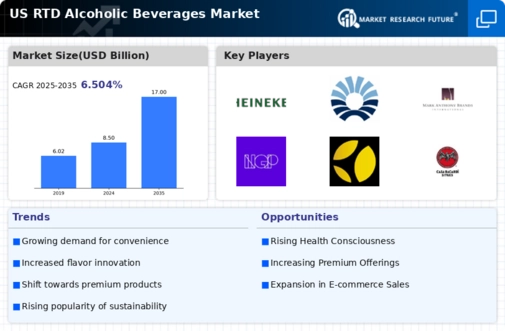Rising Demand for Convenience
The non alcoholic-rtd-beverages market experiences a notable surge in demand for convenience-driven products. Consumers increasingly favor ready-to-drink options that align with their fast-paced lifestyles. This trend is particularly pronounced among younger demographics, who prioritize on-the-go consumption. According to recent data, the convenience segment has grown by approximately 15% in the last year alone. This shift indicates a clear preference for products that require minimal preparation, thereby driving innovation in packaging and distribution. As a result, manufacturers are focusing on creating portable and easy-to-consume formats, which further enhances the appeal of non alcoholic-rtd-beverages. The industry is likely to continue evolving in response to these consumer preferences, suggesting a sustained growth trajectory in the coming years.
Expansion of Distribution Channels
The non alcoholic-rtd-beverages market benefits from the expansion of distribution channels, which enhances product accessibility. Retailers are increasingly diversifying their offerings to include a wider range of non alcoholic options, catering to the growing consumer base. E-commerce platforms have also played a pivotal role, with online sales of non alcoholic beverages rising by approximately 30% in the last year. This shift towards digital shopping reflects changing consumer behaviors, particularly among younger generations who prefer the convenience of online purchasing. As a result, brands are investing in robust distribution strategies to ensure their products are readily available across various platforms. This expansion not only increases market penetration but also fosters competition, driving innovation within the non alcoholic-rtd-beverages market.
Influence of Social Media Marketing
The non alcoholic-rtd-beverages market is significantly influenced by social media marketing strategies that engage consumers and drive brand awareness. Platforms such as Instagram and TikTok have become essential tools for brands to connect with their target audience, particularly younger consumers who are highly active on these platforms. Engaging content, influencer partnerships, and user-generated campaigns have proven effective in promoting new products and fostering brand loyalty. Recent studies suggest that brands utilizing social media marketing have experienced a growth rate of around 18% in consumer engagement. This trend indicates that effective digital marketing strategies are crucial for success in the competitive landscape of the non alcoholic-rtd-beverages market. As social media continues to evolve, brands are likely to adapt their marketing approaches to leverage these platforms for maximum impact.
Increased Focus on Natural Ingredients
The non alcoholic-rtd-beverages market is witnessing a significant shift towards natural and organic ingredients. As consumers become more health-conscious, there is a growing demand for beverages that are free from artificial additives and preservatives. This trend is reflected in the market, where products labeled as organic have seen a growth rate of around 20% over the past year. Brands are responding by reformulating existing products and introducing new lines that emphasize clean labels and transparency in sourcing. This focus on natural ingredients not only caters to health-conscious consumers but also aligns with broader trends in sustainability and ethical consumption. Consequently, the non alcoholic-rtd-beverages market is likely to see an increase in products that highlight their natural origins, appealing to a demographic that values health and wellness.
Growing Interest in Functional Beverages
The non alcoholic-rtd-beverages market is increasingly characterized by a growing interest in functional beverages that offer health benefits beyond basic hydration. Consumers are actively seeking drinks that provide added value, such as enhanced energy, improved digestion, or immune support. This trend is evident in the rise of beverages infused with vitamins, minerals, and adaptogens, which have gained popularity among health-conscious individuals. Recent market analysis indicates that functional beverages have captured approximately 25% of the total non alcoholic-rtd-beverages market share. This shift suggests that consumers are willing to invest in products that contribute to their overall well-being, prompting manufacturers to innovate and diversify their offerings. As the demand for functional beverages continues to rise, the non alcoholic-rtd-beverages market is likely to evolve to meet these changing consumer preferences.



















Leave a Comment